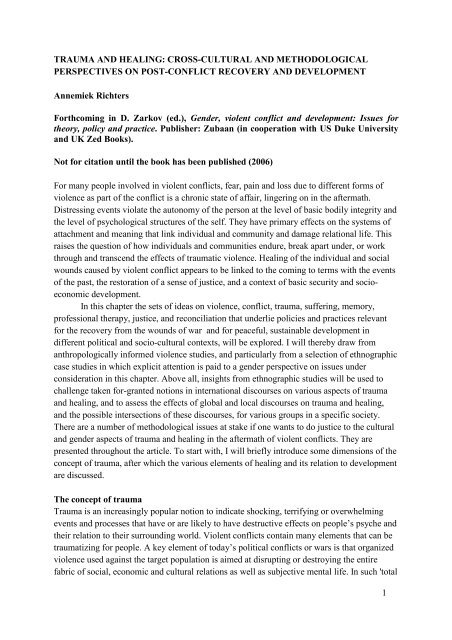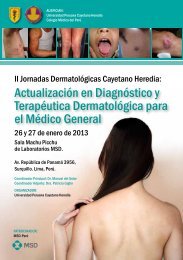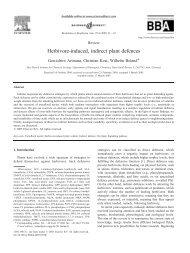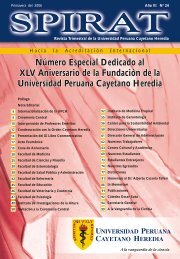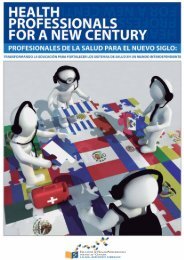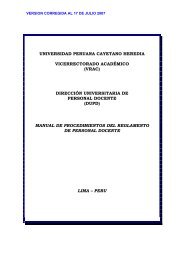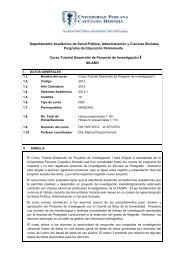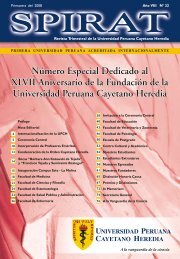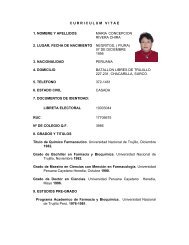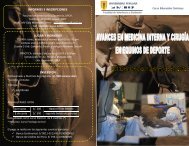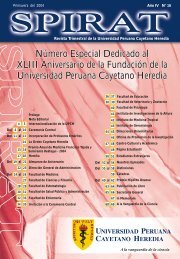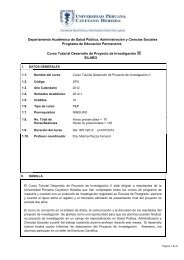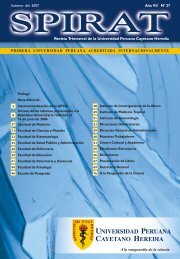1 TRAUMA AND HEALING: CROSS-CULTURAL AND ... - UPCH
1 TRAUMA AND HEALING: CROSS-CULTURAL AND ... - UPCH
1 TRAUMA AND HEALING: CROSS-CULTURAL AND ... - UPCH
Create successful ePaper yourself
Turn your PDF publications into a flip-book with our unique Google optimized e-Paper software.
<strong>TRAUMA</strong> <strong>AND</strong> <strong>HEALING</strong>: <strong>CROSS</strong>-<strong>CULTURAL</strong> <strong>AND</strong> METHODOLOGICALPERSPECTIVES ON POST-CONFLICT RECOVERY <strong>AND</strong> DEVELOPMENTAnnemiek RichtersForthcoming in D. Zarkov (ed.), Gender, violent conflict and development: Issues fortheory, policy and practice. Publisher: Zubaan (in cooperation with US Duke Universityand UK Zed Books).Not for citation until the book has been published (2006)For many people involved in violent conflicts, fear, pain and loss due to different forms ofviolence as part of the conflict is a chronic state of affair, lingering on in the aftermath.Distressing events violate the autonomy of the person at the level of basic bodily integrity andthe level of psychological structures of the self. They have primary effects on the systems ofattachment and meaning that link individual and community and damage relational life. Thisraises the question of how individuals and communities endure, break apart under, or workthrough and transcend the effects of traumatic violence. Healing of the individual and socialwounds caused by violent conflict appears to be linked to the coming to terms with the eventsof the past, the restoration of a sense of justice, and a context of basic security and socioeconomicdevelopment.In this chapter the sets of ideas on violence, conflict, trauma, suffering, memory,professional therapy, justice, and reconciliation that underlie policies and practices relevantfor the recovery from the wounds of war and for peaceful, sustainable development indifferent political and socio-cultural contexts, will be explored. I will thereby draw fromanthropologically informed violence studies, and particularly from a selection of ethnographiccase studies in which explicit attention is paid to a gender perspective on issues underconsideration in this chapter. Above all, insights from ethnographic studies will be used tochallenge taken for-granted notions in international discourses on various aspects of traumaand healing, and to assess the effects of global and local discourses on trauma and healing,and the possible intersections of these discourses, for various groups in a specific society.There are a number of methodological issues at stake if one wants to do justice to the culturaland gender aspects of trauma and healing in the aftermath of violent conflicts. They arepresented throughout the article. To start with, I will briefly introduce some dimensions of theconcept of trauma, after which the various elements of healing and its relation to developmentare discussed.The concept of traumaTrauma is an increasingly popular notion to indicate shocking, terrifying or overwhelmingevents and processes that have or are likely to have destructive effects on people’s psyche andtheir relation to their surrounding world. Violent conflicts contain many elements that can betraumatizing for people. A key element of today’s political conflicts or wars is that organizedviolence used against the target population is aimed at disrupting or destroying the entirefabric of social, economic and cultural relations as well as subjective mental life. In such 'total1
wars' psychological aggression and terror is often an important weapon in the attacker’sarsenal, leaving whole societies and its members stunned audiences, suffering from fear,anxiety, distrust and despair (Summerfield 1996).Recently the suffering due to all sorts of traumatic events is more and more capturedunder the label of ‘post-traumatic stress disorder’ (PTSD). This term has become a keysymbol in international discourses used to designate the mainly psychological consequencesof violent conflicts. Due to the globalization of trauma programs, PTSD or an indigenizationof the concept has also become part of local discourses on these consequences (see, forinstance, Bolton 2001).In the fourth edition of the Diagnostic and Statistical Manual of Mental Disorders(DSM-IV; 1994) of the American Psychiatric Association, the many symptoms following atraumatic event fall into three main categories:1. Re-experiencing the event (intrusion): distressing memories of the event; distressingdreams about the event; reliving the event by acting or feeling as if the event were recurring;intense psychological and physiological distress when exposed to situations reminiscent of theevent.2. Emotional numbing and detachment (constriction): avoiding thoughts, feelings, orconversations about the event; avoiding activities, places, or people associated with the event;having trouble recalling important aspects of the event; loss of interest in activities; feelings ofdetachment from others; inability to have love feelings towards others and a general restrictionof feelings; sense that the future is bleak.3. Hypervigilance and chronic arousal: difficulty falling or staying asleep; irritability oroutbursts of anger; difficulty concentrating; exaggerated startle response.In the aftermath of an experience of overwhelming danger, the two contradictoryresponses of intrusion and constriction establish an oscillating rhythm. With the passage of timethe symptoms may disappear. If they don’t, the symptoms of constriction become the prominentfeature of the PTSD. Since the significance of the constrictive symptoms lie in what is missing(i.e. in a lack of feelings and activities), they are not readily recognized by others (such as healthcare providers and development workers) as symptoms which have their origins in one of moretraumatic events. Because post-traumatic symptoms are so persistent and so wide-ranging, theymay be mistaken for enduring characteristics of the victim's personality. This is a costly error,for the person with unrecognized PTSD is likely to be condemned to a diminished life,tormented by memory and bounded by helplessness and fear (Herman 1992).People subjected to a prolonged, repeated conglomerate of traumatic events maydevelop an insidious, progressive form of PTSD, the syndrome of chronic trauma, whichinvades and erodes the personality even further. Chronically traumatized people no longer haveany baseline state of physical calm or comfort. Over time, they perceive their bodies as havingturned against them. They begin to complain, not only of insomnia and agitation, but also ofnumerous types of somatic symptoms. They may become so accustomed to their condition thatthey themselves also no longer recognize the connection between their bodily distresssymptoms and the climate of terror in which these symptoms were formed. Protracteddepression is the most common finding in virtually all clinical studies of chronicallytraumatized people. Every aspect of the experience of prolonged trauma works to aggravatedepressive symptoms. The chronic hyper-arousal and intrusive symptoms of PTSD fuse with2
the vegetative symptoms of depression, producing the survivor triad of insomnia, nightmaresand psychosomatic complaints. This is often coupled with a tenacious suicidality (Herman1992).A growing number of studies have noted that the category of PTSD in the Diagnosticand Statistical Manual of Mental Disorders (DSM-IV 1994) as described above does notrepresent the full spectrum of response to trauma in a variety of cultural contexts. For instance,in Rwanda after the genocide, somatically focused panic attacks seem to constitute a keyresponse to trauma on an individual level (Hagengimana 2003). It has also been observed, that,even though the disconnection between individual and society has been recognized as asymptom of traumatic stress, the debate in the West on trauma and loss has mainly beenconcerned with the long-term effects of an individual-centred event bound to soma or psyche.This is not a discourse easily translated into non-Western cultures with their differentconceptions of self and identity. There the personal impact of, for instance, physical, sexual ormental torture is perhaps registered more through the familial and social rupture which is itsinvariable accompaniment. Thus, there may be cross-cultural differences in the ordering andmanagement of traumatic experience. These differences appear to stem from culturally differentrelationships between individual and society, and between individual traumatization and socioculturaltraumatization. In some cultures the healing of a traumatized society may enjoy ahigher priority than the healing of individuals.Recently a number of ethnographic studies have confirmed the importance of socialand cultural processes in understanding the effects of organized violence in the form ofmassive or collective trauma and ways of dealing with them. In these ethnographies theconcept of social suffering, as introduced by Kleinman and colleagues (1997), is regularlyused. Included under the category of social suffering are conditions that are usually dividedamong separate fields and that are for research and intervention purposes splintered intomeasurable attributes. The conditions, however, involve health, welfare, legal, political,moral, cultural and religious issues, which form a domain that should be approached as awhole. The latter also applies to the healing from social as well as individual suffering. Anexample of such a holistic approach is the ethnography by Green (1999) on Mayan women asvictims and survivors of violent conflict in Guatemala.Fear as a way of life: Mayan widows in rural GuatemalaGuatemala suffered from a 36-year lasting civil war, which, like so many recent wars, wasdirected at the destruction of social structures and important cultural symbols. In 1996 a peacetreaty was signed. There is, however, still a high degree of impunity that pervades daily lifewith fear. Chronic fear has spread throughout the whole individual and social body. Onindividual level it regularly comes to the surface in dreams and chronic illnesses. ManyMayan women have lost their husband during the war. Their bodies since speak poignantly oftrauma and sadness, of loneliness and desolation, of poverty and doubt. While history andmemories in the past were reposited in ancestral lands, the recent war history and socialmemories of the Mayan women, of death and loss of loved ones, are sedimented in theirbodies. Their memorias de sangre (‘blood memories’), as Green names them, run throughtheir veins literally and figuratively. The widows still, after the official peace accord, live in achronic state of emotional, physical, spiritual and social pain. Pain that is difficult to3
categorize as a clinical psychiatric or somatic syndrome, such as PTSD. Such categorizationwould do injustice to what the women experience. Through their bodies the women speak ofsocial suffering due to the war in a climate of fear that suppresses other forms of speaking.While silencing is a powerful mechanism of control enforced through fear, it can also operateas a survival strategy, since speaking other than through their bodies would contribute to theendangerment of their lives.The experience of violence has not only caused suffering and cultural alienation, butalso new possibilities to deal with both and to rebuild changing ways of lives. The fact thatalmost all women suffer from similar complaints results in a new community feeling. Thecomplaints include headaches, gastritis, stomach ulcers, weakness, diarrhea, irritability,insomnia, weak blood, and folk illnesses such as nervios (nerves), susto (fright) en pena (pain,grief, sorrow). The chronic pains have become a mechanism of social commentary andpolitical consciousness. Instead of completely demolishing the women, the illnesses havereduced experiences of powerlessness as a result. The women search together for herbs in themountains, even though their headaches will not disappear until justice has been done. Thewidows do more than revitalize Mayan traditions. They develop new social networks,extending beyond traditional family ties, which give them support. This happens throughweaving activities. The weaving of cloth has always served to transmit traditions and valuesfrom the past to the next generation. Now, women reconstruct through the weaving process afeeling of identity and community life. Through their weaving they also find temporaryemotional relief.The Mayan women also find a new way of developing social ties and social supportnetworks through alignment with new fundamentalist religious movements. These movementsgained territory from the Catholic Church, which had been marked by the State as subversivebecause of its fight for social justice. The new Christian fundamentalism instead can be seenas a very conservative movement, in which one has to surrender to authority and in whichcollective identity and social actions for justice are undermined. The Pentecostal churches,however, do give space for the collective expressions of suffering through catharsis. Thewidows find in these churches a certain degree of mutual trust, cooperation, communityfeeling, dignity, and a feeling of justice. In addition, they can integrate parts of theirtraditional cosmology into a new cosmology. Thus, they make syncretistic use of varioussources available for remaking their world.The main emphasis of Green’s study lies on women’s own perspective on theirsuffering due to organized violence and their own attempts to remake their everyday life.Given the topicality of the issue, it is striking that Green does not refer to sexual violence as asource of women’s suffering and women’s way of dealing with it. From other studies on thecivil war in Guatemala we know that sexual violence against women was used as part of thewar strategy. Perhaps the women participating in Green’s research were not exposed to thiskind of violence. Another explanation could be that they did not reveal their experiences withit out of shame or because for them sexual violence was less important than the destruction oftheir life world due to loss of, for instance, their loved ones. Or, perhaps, Green chose not todiscuss the issue. Also we do not learn much about external contributions to the healingprocess in her ethnography. While Green describes briefly the detrimental effects of outsideinterventions in the form of development projects, she does not refer to international and4
national human rights and trauma programs and does not address the question if and howthese can relate to indigenous strategies for peacemaking and healing. I will start exploringthe latter issue with reference to the ethnography by Argenti-Pillen on post-war Southern SriLanka (2003). In this ethnography Argenti-Pillen recognizes that like in the communitydescribed by Green many things cannot be spoken about. Therefore, the anthropology ofsilence, often dominated by anthropology of the body, is valuable for an analysis of what goeson in the community she has studied. However, she has chosen instead to describe the ways inwhich a discourse of violence was possible after the war.Masking terror: How women contain violence in Southern Sri LankaArgenti-Pillen’s fieldwork site is a Sinhalese Buddhist rural community in southern SriLanka, Udahenagama, which has been involved in the inter-ethnic war against the Tamilseparatists in the north and east of the country and in the atrocities of a civil war of the late1980s between various insurgency and counter-insurgency forces. A cycle of low-intensityviolence between the Sinhalese army and the insurgency forces, such as the left-wingSinhalese youth movement operating under the banner of the People’s Liberation Front orJanatha Vimukthi Peramuna (JVP), has followed on the cycle of violence triggered by thecivil war. The most direct victims of both cycles of violence are men. Argenti-Pillen nevercame across any cases of women or children killed in the civil war. Women do suffer fromfear- and terror-related illnesses, but they do so in particular as the mothers, sisters, wives, andgrandmothers of the soldiers who disappeared or died.What is striking for an outsider is that, despite the suffering and losses, perpetratorsand victims on either side of the civil war continue to live together at close quarters incrowded neighborhoods. The explanation given by Argenti-Pillen is that women and childrenand the families of perpetrators more generally have been protected by a culture-specific cycleof containment of violence by means of which people were able to forestall what Argenti-Pillen (2003: 79) terms ‘modernist’ violence. The term refers to the full-blown cycle ofwidespread violence, generated through propaganda campaigns and other means by themilitarized nation-state, which targets people because of their group identity. It is women inparticular who contribute to this containment by their traditional narrative style of talkingabout violence. A characteristic of this style is the cautious and ambiguous ways of speakingabout violence and its perpetrators. The effects of political violence are expressed by relyingupon the same body of terms used to deal with intimate, domestic enemies who cannot benamed and who continue to live nearby. The dominant notion of enmity consists of anindividual enemy, not like in ‘modernist’ narratives in which a universalized enemy isdemonized or dehumanized, resulting in ‘modernist’ collective violence.People are reluctant to conceive of an undifferentiated group of people as enemy withthe result that people are not targeted merely because of their caste, class, or political andfamily affiliation. Neighborhood perpetrators and political enemies are spoken about in thesame way as very close domestic perpetrators and enemies. The same notions are used forbothersome sons and the murderers of the civil war, for both the enemies who are loved (sons)and enemies who are loathed (war criminals). In general, soft expressions are wrapped uponharsh experiences. Torture, for instance, is encapsulated in a word that also stands for a5
child’s mischief. Gentle words prevent fearful realities from imprinting themselves onpeople’s hearts.Argenti-Pillen’s analysis is that the description of violent people outside theboundaries around one’s own household with a domestic vocabulary reintegrates such peoplewithin the moral economy of the household and makes symbolic links between a victim’s anda perpetrator’s household. That means, for instance, that a widow can still be on speakingterms with the parents of her husband’s murderer. Revenge is only taken on perpetrators,leaving their households largely untouched. The application of discourses used to describedomestic moralities and violence out of context, in the wider war-torn society, played acrucial role in a culture of containment of major, `modernist’ outbreaks of violence.Recently, however, the traditional way to contain violence has come under threatunder the influence of women who have claimed that they have become `fearless’ through theatrocities they have witnessed during the civil war. Thus ‘fearlessness’ is not any longer aprerogative of men, achieved through ritual initiation into manhood or through activeparticipation in a war. ‘Fearless’ women have severed their ties with the household byrefusing to take up a role within domestic cleansing rituals for the alleviation of theirsuffering, and they argue that their children do not suffer from fear-related illnesses either.Their strategies of survival are radically opposed to those of women who suffer from `terrifiedhearts’ and the ‘gaze of the wild’ (spirit possession), and who organize domestic cleansingrituals and engage in cautious discourses on violence. One of the strategies `fearless’ womenengage in is seeking help through outside contacts, particularly contacts withnongovernmental organizations (NGOs), which for them are a much-cherished source ofstrength and hope.From the perspective of the international trauma paradigm the `fearlessness’ of womencould perhaps be interpreted as a suffering of emotional numbness, while women who sufferfrom fear-related illnesses would be seen as having reacted to the atrocities they witnessedwith dissociation and trance. If we go beyond this individualistic, disease-oriented approach,Argenti-Pillen argues, we see that the experience of `fearlessness’ - whether or not theequivalent of emotional numbness - of a large number of people may have as an effect thedisruption of the traditional discourses on violence, and the cycle of containment of violencethat goes along with it, within the community as a whole. While reacting to the same crisissituation, the group of `fearful’ and the group of `fearless’ women advocate opposing modelsof postwar societal reorganization. Women may transfer the `fearlessness’ to their offspring,which may then lead them to refrain from the cautious discourses on violence of theirmothers’ generation which are vital in the containment of violence. The argument made byArgenti-Pillen is that once traditional, culture-specific mechanisms fail to function,communities such as Udahenagama may become vulnerable to a cycle of much morewidespread, `modernist’ violence of the type we have witnessed in Cambodia, Rwanda, orKosovo.The issue Argenti-Pillen proposes as worth investigating is whether the assumptionbehind the implementation of NGO trauma counseling programs in non-Western societies thatthese programs can contribute to the interruption of the cycle of violence, holds for a situationas she finds it in Southern Sri Lanka. The programs there are oriented toward a specific targetgroup: victims of torture, families of the disappeared, and the internally displaced. Women6
who are afflicted by the violence and who are only familiar with local categories of violencein which the distinction between ‘domestic’ violence and ‘political’ violence does not exist,thus learn about such foreign distinctions when they are selected or rejected by the mentalhealth NGOs. The result of the selection process is that the principle target groups of theseNGOs are widows and mothers of the disappeared. It is especially ‘fearless women’ whoparticipate in the NGO activities and who are trained as counselors.What is worrisome to Argenti-Pillen is that, while the majority of the communityconsiders `fearlessness’ as an aberration, the NGO activities provide an outside legitimizationfor it. The NGOs support `fearlessness’ as a viable form of sociability. Don’t they by doing socontribute to the cycle of violence in the long term instead of replacing a traditional by a‘modern’ way of containment of that cycle? On the basis of the evidence Argenti-Pillenprovides, she proposes that the cultural side effects of the discourse on trauma become centralin debates concerning the effects of the implementation of humanitarian trauma counselingprograms in war-torn societies, particularly with regards to effects on the cycle of violence.Following De Alwis (2004) in her critical review of the book by Argenti-Pillen, wemay question if and to what extent it is indeed the introduction of the international traumadiscourse that contributes to the infringement on cultural mechanisms for the containment ofviolence, or whether (also) other factors are involved. According to De Alwis the category ofthe fearless woman is not a new phenomenon arisen out of women’s responses to violence.Furthermore, an unquestioning faith in ‘tradition’ as Argenti-Pillen seems to have, overlooksthe negative aspects tradition entails for women while leaving the perpetrator out of theanalysis. Based on other ‘trauma literature’ on Sri Lanka, De Alwis’ position is “that weshould not underestimate the resilience and resolve of wounded individuals and societies toseek solace in whatever rituals or systems of healing they may encounter – be they familiar orunfamiliar – and transform them in the process” (p. 107). This statement, however, also leavestoo much unquestioned, particularly the politics - on international, national, community andinterpersonal levels - that influence visions on how healing should be achieved. Who decides,for instance, for or against the implementation of a particular healing system? Are women’sspecific healing needs taken care of in such a system? Do all women have access to thesystem? And does the system contribute to peace or to even more violence?The presupposition of the trauma discourse is, as I already mentioned, that it isprecisely trauma counseling services that may help to break cycles of violence, and releasecreative energy needed for the restructuring and development of society. The merit of theapproach taken by Argenti-Pillen is that she does not take this presupposition for granted, anissue to which I will return. Her ethnography points at least to the need for more criticalstudies of the effects of trauma counseling programs on a social level as compared to effectsof other programs, such as human rights ones. Are human rights programs indeed moreeffective than trauma programs for the healing of individual and social trauma, as has beenargued, for instance, by Summerfield (1996)? Could both kinds of programs perhaps reinforceeach other? Or, to broaden these questions, is there a relation between justice and healing, andif so, what kind of relation?7
Justice and healingThe restoration of a sense of justice and the coming to terms with the events of the past appearto be central elements of healing from the wounds of organized violence. People’s posttraumaticsymptoms after war are not just a private and individual problem, but also anindictment of the social context that produced all sorts of injustices (Richters 2001a). Thelanguage of human rights is increasingly used as a vehicle to reinstate justice and therebycontribute to healing. Human rights can be seen as one of the most globalised political valuesof our times. In countries around the world, including Guatemala and Sri Lanka, truthcommissions have been established to confront the massive human rights abuses. Thesecommissions link together complex ideas about suffering, justice, human rights, history,witnessing, accountability, forgiveness and reconciliation. In addition, a rhetoric abouthealing has accompanied many commissions’ work, with the powerful claim that truth healsthe individual and social body. 1 South Africa provides a powerful example of the use ofmetaphors of illness and healing in describing the work of the Truth and ReconciliationCommission (TRC). Commissioners and social commentators frequently compared, forinstance, truth-telling with the opening and cleansing of unhealed wounds caused by grossviolations of human rights. Words like ‘wound’, ‘fester, ‘cleanse’ and ‘operation’ were usedto describe aspects of the Commission’s work (Ross 2003:12). But, as critiques argue, thevery idea that individuals and nations can heal and ultimately recover from violence falls preyto inappropriate and impoverished medical and psychological metaphors. The history ofhuman violence teaches us that there are few happy endings (Scheper-Hughes & Bourgois2004:27). Another frequently made criticism of the work of the Commission is that talk ofreconciliation and of restorative justice has sidetracked the legitimate demand for retributivejustice (Wilson 2001). Also, the way sexual violence against women was treated by localcommissions has left much to be desired.Meanwhile a basic forceful critique of the rise of human rights as the main universalstandard against which to judge violence and suffering has been formulated. Hastrup (2003),for instance, argues that rights-based conceptions of justice distort our understanding ofsuffering and pare down social and moral narratives. Legal language instrumentalizes, cuttingout the symbolic and expressive dimensions of violence. Instead of giving voice to people,victims of violence are often silenced by truth commissions. In her study of the South Africantruth commission, Ross (2003) demonstrates the paucity of mechanisms the commission hadavailable to give voice to suffering and receive acknowledgment for it. Another language ofsocial suffering than the legal one, she argues, would be needed to permit the expression ofthe full range of experiences, admit the integrity of silence, recognize the fragmented andunfinished nature of social recovery; a language that does not presume closure (p. 165).While public discursive spaces in the form of truth commissions and war crimestribunals for healing have been created in many countries, governments in other countrieshave shifted hurt out of the public domain. In postwar Nigeria the underlying premise wasthat healing of postwar trauma can be done socially, and that the practice of such healingtakes place at the level of the community (Last 1999). Nigeria did not have a war crimetribunal and court records. The Biafran civilians, the defeated party, have a different truth; the“truth of the creative imagination in oral history and literature, which mostly are where thewar experiences are being revisited and recorded” (Adamiume 2000:54). Also in the8
Mozambican case the deafening silence of the state has rendered intersubjective healingthrough public dialogues about a painful past, exceedingly difficult (Hayner 2001, West2003). Another example is Sri Lanka, where, according to Perera (2001), justice in the secularand legal sense has not yet been achieved. Instead, possessions and ghost stories have givenpeople an opportunity to express their hatred as well as expectations of justice and revenge ina socially and ritually accepted fashion. Next to, or instead of, a secular system of law, thejustice of the deity is invoked (Perera 2001).Igreja (2003) describes how traditional healers on community level contribute tohealing and justice. In healing ceremonies in Gorongosa district in the center of Mozambiqueit is the spirit who decides how justice and reparation can be achieved in order to restore thehealth of patients and their family. According to Igreja’s informants, the post-war “femalespirits do not emerge to possess male bodies due to the fact that women are the ones whoreceive orders in society whilst men do not accept to be exploited. The men manage to goahead.” The spirit-led type of justice follows socio-cultural and historical norms and practices.It is informed by a belief that in case of an innocent death, the spirit of the deceased person iscapable to return to the realm of the living to make justice. The existence of different forms oflocal justice is not the result of the failure of a secular system of justice, as suggested byPerera for Sri Lanka. According to the Gorongosa perspectives on justice, the effectiveness ofthe secular justice system does not impair the spirits of the innocent dead victims to pursuejustice on their own terms. 2In Rwanda a middle course was adopted. The government recognized the importanceof justice for the rebuilding of society. It came to the conclusion, however, that the regularsecular judicial system cannot answer all the justice problems Rwanda was facing and camewith a proposal of a unique Rwandan solution: an adapted form of state justice in the form ofGacaca tribunals. These tribunals were to operate along with a system of justice on nationaland international level. They stand for a reinvented traditional way of participatory justice,which involves gathering information from the community and punishment. The future willtell whether this hoped-for instrument of alternative justice will reach the goals set, whether itwill contribute in any way to healing the wounds of the past and whether gender justice willbe done (see Mibenge in this volume). It is generally acknowledged that the Gacaca tribunalsmay also open up further abuse of human rights as well as re-traumatization. The latter isevident, for instance, in a story I heard while visiting Rwanda in 2004. A man accused ofvarious war crimes stated before the Gacaca court that he had raped a woman whom hementioned by name. She was present in the audience. After the genocide she had married, butconcealed the rape to her husband. The result of the Gacaca trial was not only that she relivedthe rape experience, but that she from then on had to live with the stigma commonly attachedby Rwandan society to the women who have been raped.Hastrup (2003) observes that ethnographies of cruelty show that violence in thecommunities under investigation is rarely represented in terms of violations of rights. Thismay change in the near future. Working for a project in post-conflict Tajikistan targetingviolence against women and its health effects, I observed that for the many abused women inthis country it can be a relief to learn that something like ‘human rights’ exists and that thehuman rights framework can be used for the fight against gender violence (Richters 2001b). Itis not unlikely that women’s voicing of these issues may be represented in future9
ethnographies or that anthropologists at least use the human rights framework in theirrepresentations of the suffering due to violence.While anthropologists in the past have positioned themselves in critical opposition touniversal values and transnational processes such as ‘human rights’, it has recently beendefended that they should make greater use of the human rights framework in theirtheoretical, action- or policy-oriented analyses of social transformations (Messer 1993:225).Wilson (1997a) proposes an ‘existential ethnography of rights’. He argues that, while mosthuman rights reports “strip events free of actors’ consciousness and socio-cultural contexts”,“it is part of anthropologists’ brief to restore the richness of subjectivities, and chart thecomplex fields of social relations, contradictory values and the emotional accompaniment tomacro-structures that human rights account often exclude” (p. 15). The contextualization ofpeople’s narratives about experienced violence and human rights abuses and their suffering asa consequence of it, is not only needed in order to compensate for the individualised, a-cultural, deracinated and therefore universalistic nature of most human rights accounts(Wilson 1997b:157), but also of most medical accounts of human suffering as a consequenceof human rights abuses.Memory and healingA key methodological issue in capturing people’s stories about their suffering is the issue ofmemory to which I will now turn. Violence is experienced in bodies, but also in memories. Inher ethnography on violent memories among Mayan K’iche’ war widows in Guatemala, Zur(1998) interprets the entire history of la violencia in that country as a war against memory.The military state attempted in various ways to deny people access to truth. Forced to ‘forget’the episodes of violence the Mayan women witnessed and experienced and to repress paincaused by their losses, the women’s pain re-emerged as physical pain. Like the Mayanwidows in Green’s study, the K’iche’ widows have embodied the painful experiences theyhave been unable to articulate as a result of being silenced and of the non-narratability ofatrocious experiences. Knowing what not to know has become a major coping response toterror. This may explain that organized rape, which according to Zur (1998) was used againstMayan women as part of the war in Guatemala, does not feature in Green’s book. The past isproduced through private memory and, as such, can be distinguished from the dominantmemory, which is produced through ‘public representations of history’. In the latter, certainexperiences, such as women’s experiences with rape, are silenced, as is described by Declich(2001) in her analysis of the gendered production of memories of war violence in Somalia.Zur’s case study raises a problem that has a wide significance. How doesremembrance take place in post-conflict societies when forgetting seems an act of salvation,when silence is still experienced to be the best survival strategy? How is the past retrievedwhen powerful social institutions, individual actors and the fallibility of memory itself allconspire to redefine what took place? The K’iche’ women eventually succeeded in surpassingthe silence enforced by the state and did retell and rework their memories in an attempt toresolve them. Constructing narratives collectively is for them a means of coming to termswith the events of the past and integrating them into their lives in a way that makes sense inthe present. Zur (1998:171) describes this process as a creative and a healing one, a processthat makes the unknown known and less frightening. Memory, however, is tangled in trauma,10
and unravelling the tangle can itself be traumatic. This raises a central question in ‘traumatherapy’ on an individual as well as a social level: when, how and to what extent should thepast be sealed or re-opened in order to be able to work towards a better future. And how domemory constructions on the level of an individual, a group and the state relate to each other?Foxen (2000:378), for instance, writes in an article on a Mayan narrative of remembrance andforgetting in Guatemala that the silences, ambivalences, syncretistic discourses andcontradictions of Mayan narrative style and traumatic memory are not indulged incourtrooms. She points to the cacophony of voices in the process of recovering a collectivememory of the violence for the purpose of healing and re-entering history after decades offear and silence. There is still a cleavage between ambivalent, shifting memory processes andthe more coherent histories necessitated by urgent political processes. Like elsewhere, theconstruction of those histories by promoters of human rights will undoubtedly clash with thehistory those in power construct.Various authors in a book edited by Das et al. (2001) on ‘remaking the world’ addressthe relation between collective memories and individual memories, highlighting thedisjunction between public culture, official memories, and the ‘sensory’ memory ofindividuals. Two themes stand out in their work: that of contesting the history of officialinattention to individual and social suffering and that of using the sensory memory ofindividuals to challenge the official memory created through the official record. The issueraised in various critical writings on the work on truth commissions, however, is precisely thatmemory construction through the official record takes place that does not permit theexpression of a range of sensory memories, particularly not those of women as Krog (2001)and Ross (2003) demonstrate for South Africa. Not only the stories of women as victims didnot become part of the collective memory. Older people, for instance, did suffer from thesystem of apartheid and some of them were actively involved in the struggle. But many ofthem do not belong to one of the two groups – perpetrators and victims – that were so clearlydistinguished in the work of the Truth and Reconciliation Commission. They were‘bystanders’ and as such neglected in the national fabric of commemoration during the TRCsessions (Van Dongen 2004).Collective memory influences, positively and negatively, attempts of healing ruinedmemories and procures social justice in post-conflict situations. This raises the question ofhow therapeutic interventions relate to collective memorizing. How, for instance, cantherapeutic interventions initiate changes in shared psychological states of traumatizedpersons in a way that the hegemonic collective memory that keeps the cycle of violencegoing, is challenged? Narratives, including those constructed in therapies, can keep thememory of former conflicts alive in stories, either by glorifying one’s own group’sachievements and benefits or by emphasizing the perceived injustice, losses or sufferingincurred by one’s own group. This type of social memory can be easily capitalized upon bystate elites and elaborated into a hegemonic ideology of violence. Volkan (2000), in contrastto Argenti-Pillen (2003), suggests that there is a special role for mental health workers inbreaking the cycle of the traumatized and traumatizing society. NGOs that deal withtraumatized societies need to recognize the shared psychological problems and maladaptivesocietal changes that may lead to future conflict because of trans-generational transmission.Children of parents traumatized by ethnic or other large-group conflicts may see it as their11
task to keep the ‘memory’ of the parents’ trauma alive, and to take revenge on their behalf.Therapeutic interventions and ‘psycho-political dialogues’ are needed to break that cycle ofrevenge. This kind of preventive public health work is by necessity long-term work. Thequestion is also when to make a start with it. Setting up a ‘trauma program’ in besiegedSarajevo in 1994 for Doctors without Borders I tried to pay attention to such preventive workin the training program for counselors. It did not work. Most trainees, being involved in dayto-daysurvival and never having learned to reflect critically on one’s own history, were notready for it, yet. Only now, ten years later, I am told by some of them, the time is ripe for thiskind of work. That this critical reflection is necessary, also in therapeutic interventions, inorder to contain violence instead of reviving it, is illustrated by the following ethnographiccase study.Kidron (2003) studied the construction of trauma descendant identity in a supportgroup of descendants of Holocaust survivors experiencing previously unarticulated andunclassified psychosocial ills in daily life. The ratio of female-male participants was three toone. The participants in the group were led by the facilitator to construct a narrative in whichthe plot of their personal life stories was constituted by the distant past. The facilitator starteda session with a monologue informing the group of one specific psychosocial attribute ofsecond-generation identity, such as issues surrounding separation or intimacy. In such amonologue, the facilitator asked, for instance, ‘Are we allowing our children to separate fromus or are we afraid that separation is as traumatic for us as it was for our parents?’ (Kidron2003: 521). The scenarios presented at the start of each session functioned as a keymechanism in the descendant’s memory work, making him or her remember past separationorintimacy-related traumatic childhood events and causally explaining present crises byhistorical trauma. The discursive practices used in descendants’ narratives are ultimatelycarriers of memory, which both sustains and revitalizes historical grand narratives and thecultural scenarios they embed. The last issue raised for discussion in the final session is howone may transmit the burden of memory and testimony to the next generation because ‘wewant them to know and feel’ the burden (Kidron 2004: 531). Thus, the second generationHolocaust descendants turns its children into a third-generation descendants that will continueto carry the traumatic past.Kidron argues, similar to Argenti-Pillen above, that the potential of illness constructsas a collective mnemonic tool must be further explored. Future research may also exploregroup memory work as expanding its cultural horizon from tales of individual distress to talesof collective catastrophes and collective identities in the making. Considering theglobalization of Western trauma therapies based on the psychiatric PTSD concept to conflictriddenareas around the world, the questions raised by Kidron are pertinent. For her theconjunction of the person-centred psychological illness construct, with a collectivecommemorative agenda, raises perhaps the most interesting questions.The final issue that resulted from Kidron’s ethnographic study is whether culturespecificconcepts and healing practices from around the world have merged with importedPTSD therapies to allow for recovery and closure, or whether global trends in the politics ofremembering and forgetting have brought about an evolution of the concepts of healing,witnessing and survivorship to produce eternally wounded survivors of distant pasts, and, Iwould add, an accompanying eternal lust for revenge. Another side of the coin is that the12
globalizing Western PTSD approach to memory can also contribute to selective forgetting -the forgetting of social suffering, collective responsibility and guilt (Van Dongen 2002). Therole of the various kinds of trauma healing – such as the ‘working through of trauma’ orlearning to live with the trauma – that take place around the world in memory-politics is oneof the issues that could be further explored in anthropological research. The references I madeabove to ethnographic work focusing on women and trauma, make clear that attention togender-specific issues in this research is needed if one wants to understand what is often notarticulated in group’s war memories, and to do justice to women’s pain and memories.Challenges for the anthropology of trauma and healing and its relevance fordevelopmentIn this chapter I have discussed the possible impeding impact of the continuous effects of warin the form of individual and collective suffering on so-called post-conflict development. Inorder to assess this impact one should apply Western evaluative constructs such as the PTSDparadigm with caution. Other mental health problems as a consequence of the war, such asdepression, may be more prevalent than PTSD. In addition, PTSD and other Western mentalhealth constructs may not capture the problems people really suffer from, such as spiritpossession, a condition that troubles especially women. It may also be that poverty andeconomic hardships resulting from a lack of development are ranked as the number oneproblem experienced by the population affected by violent conflict and that psychologicalproblems are ranked at the end of the list. In order to determine what it is that people need(most) in the immediate or more distant post-conflict period that can contribute to theprevention of further violence and trauma, information provided by anthropologicallyinformed violence studies is crucial. A PTSD approach used for the evaluation of problemsthat need attention in the post-conflict phase should not, however, too easily be rejected.There is more and more evidence that symptoms as described by PTSD are a universalresponse to severe traumatic events, but that the way people cope with these symptoms can beculturally diverse.Anthropologically and epidemiological informed PTSD studies do have theirrelevance. Pham et al. (2004), for instance, found that people with PTSD symptoms almosteight years after the genocide in Rwanda were less open to reconciliation than people withoutthose symptoms. We may consider this type of finding informative for development thinking,policy and practice. PTSD data may also be used as a powerful critique of political violenceand for securing justice. The point is, however, that there may be more people without PTSDdiagnosis but suffering from other mental health problems due to violent conflicts, who maybe able to contribute less to development than those who do display symptoms characteristicof PTSD.The anthropology of violence and terror and related suffering and healing is arelatively new field within anthropology that is faced with a number of challenges. As thebody of research in this field grows, so too grows the frequency with which anthropologistsare thrust or are thrusting themselves into dangerous fields. In these fields customaryapproaches, methods, and ethics of anthropological fieldwork may be insufficient, irrelevant,inapplicable, imprudent or simply naïve. What are needed are updated field strategies forresearch amid the menace of violence, including pragmatic strategies for dealing with threats13
of safety, security and well being of anthropologists and informants. 3 Researchers shouldknow the various symptoms of posttraumatic stress. If they want to question people abouttheir war experiences and do an appeal to people’s memory, they should, for methodologicaland ethical reasons, be aware that memorizing may reopen wounds which people for the sakeof their own health and the health of the nation may want to forget (Tankink 2004).A methodological problem of a different nature is the unbridgeable gap between thetheoretical models at our disposal and the unfathomable depths of human suffering. Traumaticevents are per definition incomprehensible because partial forgetting is a definingcharacteristic of trauma. And what is remembered may be silenced because it is unspeakable,too painful to tell, or culturally and/or politically silenced. 4 Anthropologists, however, mayhave ‘the privilege’ to break this silence. As one of West’s (2003:356) informants told him:“Only someone like you can get at this history – only someone from outside”. West gatheredlife stories of men who had been the victims of torture at the hands of the Portuguese duringthe Mozambican war for independence. Decades after their experience of violence, West as anoutsider created the opportunity for them to finally ‘whisper’ about their ordeal to him as aforeigner. He openly writes about the feelings the listening to the stories of his informants lefthim with, feelings of exhaustion, bewilderment, outrage, revulsion and confusion. Havingchosen to conduct research in an area of Mozambique only marginally affected by the civilwar, West was unexpectedly drawn into the topic of violence and suffering. Like otheranthropologists in similar situations, he hesitated to ask questions, fearing that he might beforcing these men to relive the violence once done to them. At the same time, however, hesensed that his failure to appropriately acknowledge the accounts these men shared mightconstitute another form of violence against them. Nevertheless, it took him some time todecide what to do with these narratives, whether to retell them, to whom and with whatpurpose.In contrast to West, Hatzfeld (2003), a war reporter for decades, deliberately held indepthinterviews with men involved in the war in Rwanda in 1994, not as victims but asperpetrators. The result gives us a fascinating but distressing insight into the psychology ofthe perpetrators, in the banality of evil or evil of banality, in the unimaginable, and in thereasons behind it. Trying to understand what happened in Rwanda proved to be a painful task,which, according to Sontag (2003), we should not avoid; not if we are adults with aconscience.How can anthropology contribute to help people understand the atrocities as theyhappened in Rwanda and other wars and how to speak to people’s conscience? Here we areconfronted with the issue what the public role of the anthropology of violence can and shouldbe. How can anthropologists contribute, for instance, to overcoming various states of denialby victims, perpetrators or bystanders, whether on the level of individuals, groups of people,or governments (Cohen 2001)? What particularly comes to mind in reference to a country likeRwanda are governments that are responsible for atrocities; those that did not take theirresponsibility to intervene in order to end or prevent conflict, and those that ignore thesuffering of (large parts of) the population in the post-war situation.Anthropological studies until now have focused mainly on the victims of violence; onthe suffering as a consequence of violence and the various ways to deal with the suffering.The strength of many of these studies is their phenomenological descriptions. One of their14
weaknesses is that they may reinforce a tendency to abdicate efforts to comparativeexplanation. Comparative research may, for instance, identify that rape is not always part of awar strategy, and explain why this is likely to be so (Haydn 2000). While most theories on thecauses, meanings, and consequences of organized violence come from history, psychology,psychiatry, psychoanalysis, theology, comparative law, human rights and political science,relatively recent studies in anthropology, gender and public mental health can be added to thislist. What is specific to anthropology and gender studies is that they try to develop anintegrative perspective in their theorizing. As far as trauma and healing is concerned, this is aperspective that should be aligned with public mental health theory, and more generally withdevelopment theories, as well as interventions based on those theories.In the anthropological work discussed in this chapter a number of theoretical issuesstand out. They include, among others, linkages between complex ideas about suffering,justice, human rights, history, witnessing, accountability, forgiveness, reconciliation andhealing; culture and the universality of human rights; the meaning of socio-cultural healingand the re-creation of the ‘normal’; the relation between collective memory, individualexperience and healing; the creation of an alternative public space to counter the silencecreated by state-sanctioned narratives for the sake of healing; the recovery of voice aftertrauma and tragedy; the role of religion and justice in healing; the embodiment of violence;ethical issues and the (public) role of the anthropologist concerning social reform aimed at thepromotion and protection of human rights.What anthropologists have to offer in particular to development theory, policy andpractice, and within that context to public mental health, is their empirical work done invarious cultures and the cross-cultural perspectives derived from it. Because of the previousneglect in anthropological studies of victim’s own perspective on their suffering, ‘experience’as the most authentic form of knowledge was privileged in anthropological writings at first.Gradually, however, a move has been made to address issues of health and healing also fromother perspectives, such as, historical, institutional, structural and comparative ones. Theethnographic examples given in this chapter underscore the relevance of also incorporating agender perspective on the experiential side of trauma and healing and its complex individualand collective meanings, as well as of doing it within a culture-specific, integrative analysis.References:Alwis, M. de, 2004, ‘Review essay’. Medical Anthropology Quarterly, 18(1): 104-108.Amadiume, I., 2000, ‘The politics of memory: Biafra and intellectual responsibility’, in I.Amadiume & A. An-Na’im (eds.), The politics of memory: Truth, healing and social justice,London: Zed Books, pp. 38-56.Argenti-Pillen, A., 2003, Masking terror: How women contain violence in Southern Sri Lanka,Philadelphia: University of Pennsylvania Press.Bolton, P., 2001, ‘Local perceptions of the mental health effects of the Rwandan genocide’, TheJournal of Nervous and Mental Disease, 189(4): 243-248.Cohen, S., 2001, States of denial: Knowing about atrocities and suffering, London: Polity Press.15
Das, V. et al. (eds.), 2001, Remaking a world : Violence, social suffering and recovery,Berkeley: University of California Press.Declich, F., 2000, ‘When silence makes history: Gender and memories of war violence fromSomalia’, in B.E. Schmidt & I.W. Schröder (eds.), Anthropology of violence and conflict,London: Routledge, pp. 161-176.Dongen, E., 2002, ‘Trauma en de politiek van vergeten en herinneren: Een antropoloog kijktnaar de ‘trauma business’’, in H. Bot et al. (eds.), Culturen op de vlucht: Over detransculturele psychiatrische zorg aan asielzoekers en vluchtelingen, Wolfheze: AfdelingPhoenix, de Gelderse Roos Geestelijke Gezondheidszorg, pp. 101-107.Dongen, E., 2004, ‘Remembering in times of misery: Can older people in South Africa ‘workthrough’?’, Working paper for the Amsterdam School for Social Science Research(www.assr.nl).Foxen, P., 2000, ‘Cacophony of voices: A K’íche’ Mayan narrative of remembrance andforgetting’, Transcultural Psychiatry, 37(3): 355-383.Green, L., 1999, Fear as a way of life: Mayan widows in rural Guatemala, New York:Columbia University Press.Hagengimana, A. et al., 2003, ‘Somatic panick-attack equivalents in a community sample ofRwandan widows who survived the 1994 genocide’, Psychiatry Research, 117(1): 1-9.Hastrup, K., 2003, ‘Violence, suffering and human rights: Anthropological reflections’,Anthropology Theory, 3(3): 309-325.Hatzfeld, J., 2003, Une saison des machettes : Les tueurs parlent, Paris: Editions du Seuil.Hayden, R.M., 2000, ‘Rape and rape avoidance in ethno-national conflicts: Sexual violence inliminalized states’, American Anthropologist, 102(1): 27-42.Hayner, P.B., 2001, Unspeakable truths: Confronting state terror and atrocity, New York:Routledge.Herman, J., 1992, Trauma and recovery. The aftermath of violence: From domestic abuse tostate terror, New York: Basic Books.Honwana, A., 1998, ‘Sealing the past, facing the future: Trauma healing in ruralMozambique’, Accord, 3: 75-80.Igreja, V., 2003, ‘‘Why are there so many drums playing until dawn?’: Exploring the role ofgamba spirits and healers in the post-war recovery period in Gorongosa, CentralMozambique’, Transcultural Psychiatry, 40(4): 459-487.Kidron, C.A., 2003, ‘Surviving a distant past: A case study of the cultural construction oftrauma descendant identity’, Ethos, 31(4): 513-544.16
Kleinman, A. et al. (eds.), 1997, Social suffering, Berkeley: University of California Press.Kovats-Bernat, J.C., 2002, ‘Negotiating dangerous fields: Pragmatic strategies for fieldworkamid violence and terror’, American Anthropologist, 104(1): 208-222.Krog, A., 2001, ‘Locked into loss and silence: Testimonies of gender and violence at theSouth African Truth Commission’, in C.O.N. Moser & F.C. Clark, (eds.), Victims,perpetrators or actors? Gender, armed conflict and violence, London: Zed Books, pp. 203-217.Last, M., 2000, ‘Reconciliation and memory’, in V. Das et al. (eds.), Violence andsubjectivity, Berkeley: University of California Press, pp. 315-333.Messer, E., 1993, ‘Anthropology and Human Rights’, Annual Review of Anthropology, 22:221-249.Nordstrom, C. & Robben A.C.G.M. (eds.), 1995, Fieldwork under fire: Contemporary studiesof violence and survival, Berkeley: University of California Press.Perera, S., 2000, ‘Spirit possessions and avenging ghosts: Stories of supernatural activity asnarratives of terror and mechanisms of coping and remembering’, in V. Das et. al. (eds.),Remaking the world: Violence, social suffering and recovery, Berkeley: University ofCalifornia Press, pp. 157-200.Pham, P.N., Weinstein, J.W. & Longman T., 2004, ‘Trauma and PTSD symptoms in Rwanda:Implications for attitudes toward justice and reconciliation’, JAMA, 292(5): 602-613.Richters, A., 2001a, ‘Trauma as a permanent indictment of injustice: A socio-cultural critiqueor DSM-III and DSM-IV’, in M. Verwey (ed.), Trauma und Ressourcen, Berlin: Verlag fürWissenschaft und Bildung, pp. 53-75.Richters, A., 2001b, ‘Gender violence, trauma and healing in situations of ethno-nationalconflicts: The cases of former Yugoslavia and Tajikistan’, in F. Reysoo (ed.), Hommes armés,femmes aguerries: Rapports de genre en situations de conflict armé, Berne: Commissionnationale suisse pour UNESCO, pp. 137-165.Ross, F.C., 2003, Bearing witness: Women and the Truth and Reconciliation Commission inSouth Africa, London: Pluto Press.Scheper-Hughes, N. & Bourgois, P. (eds.), 2004, Violence in war and peace: An anthology,Malden, MA: Blackwell.Sontag, S., 2003, ‘Préface’, in J. Hatzfeld, Hatzfeld, J., 2003, Une saison des machettes : Lestueurs parlent, Paris: Editions du Seuil.Summerfield, D., 1996, ‘The impact of war and atrocity on civilian populations: Basicprinciples for NGO interventions and a critique of psychosocial trauma projects’, London:Relief and Rehabilitation Network, ODI.17
Tankink, M., 2004, ‘Not talking about traumatic experiences: Harmful or healing? Copingwith war memories in southwest Uganda’, Intervention: International Journal of MentalHealth, Psychological Work and Counselling in Areas of Armed Conflict, 2(1): 3-18.Todeschini, M., 2001, ‘The bombs’s womb? Women and the atom bomb’, in V. Das et al.(eds.), Remaking the world: Violence, social suffering and recovery, Berkeley: University ofCalifornia Press, pp. 102-157.Volkan, V., 2000, ‘Traumatized societies and psychological care: Expanding the concept ofpreventive medicine’, Mind and Human Interaction, 11(3): 177-194.West, H.G., 2003, ‘Voices twice silenced: Betrayal and mourning at colonialism’s end inMozambique’, Anthropological Theory, 3(3): 343-365.Wilson, R. A. (ed.),1997a, ‘Human rights, culture and context: An introduction’, in R.A.Wilson (ed.), Human rights, culture and context: Anthropological perspectives, London:Pluto Press, pp. 1-28.Wilson, R. A., 1997b, ‘Representing human rights violations: Social contexts andsubjectivities’, in R.A. Wilson, Human rights, culture and context: Anthropologicalperspectives, London: Pluto Press, pp. 134-161.Wilson, R.A., 2001, The politics of truth and reconciliation in South Africa: Legitimizing thepost-apartheid state, Cambridge: Cambridge University Press.Zur, J.N., 1998, Violent memories: Mayan war widows in Guatemala, Boulder, Colorado:Westview Press.Endnotes:In thank Marian Tankink and Dubravka Zarkov for their comments on drafts of this chapter.1 Cf. e.g. Hayner 2001, Wilson 2001, Hastrup 2003, and Ross 2003.2 Personal communication with Igreja 2004.3 See especially Nordstrom & Robben 1995, and Kovats-Bernat 2002.4 See Sheriff 2000, Todeschini 2001, Ross 2001, West 2003.18


